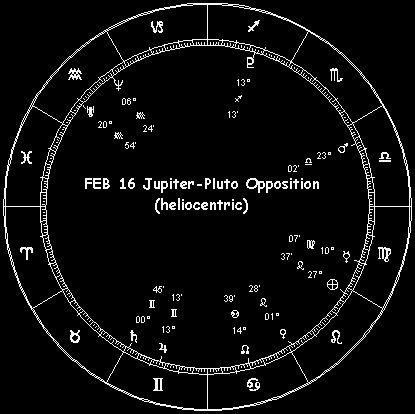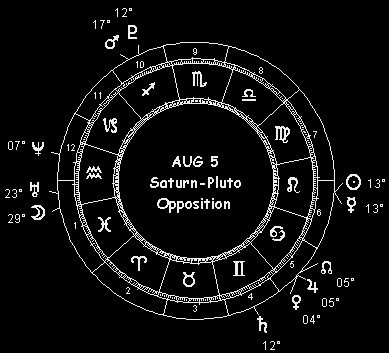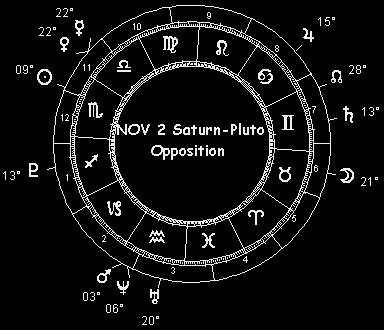If you were expecting some kind of sun sign nonsense, forget it. This is real astrology. See the section above. Please note: this forecast is expressed in terms of Universal Time (UT). Current UT date and time appear at the top of this page. (To update display, use your browser's reload/refresh button.)
Years have personalities as much as people do, if you're sensitive to that kind of thing. The year 2000, the last one in the second millennium of the common era (CE), was as predicted a time of harvest:
If Jupiter and Saturn meet,
What a crop of mummy wheat!
(W. B. Yeats, Supernatural Songs, 1935)
 Jupiter and Saturn did indeed meet, as they aligned in the sign Taurus and pulled the rug out from some of the world's formerly most lucrative financial markets. It was harvest time in the dot-com world, as I warned it would be. If you did as I suggested and ran for the cover of quality blue chips (and selected quality computer and communications and Internet infrastructure builders), you should have dodged the reaper last year. After all, 2000 was a year of Jupiter-Pluto oppositions, a time when the hi-tech high fliers ended up getting finely ground through the mill. It's not over yet, what with a couple more appearances of the Jupiter-Pluto alignment - one heliocentric, one geocentric - but the lion's share is behind us now.
Jupiter and Saturn did indeed meet, as they aligned in the sign Taurus and pulled the rug out from some of the world's formerly most lucrative financial markets. It was harvest time in the dot-com world, as I warned it would be. If you did as I suggested and ran for the cover of quality blue chips (and selected quality computer and communications and Internet infrastructure builders), you should have dodged the reaper last year. After all, 2000 was a year of Jupiter-Pluto oppositions, a time when the hi-tech high fliers ended up getting finely ground through the mill. It's not over yet, what with a couple more appearances of the Jupiter-Pluto alignment - one heliocentric, one geocentric - but the lion's share is behind us now.
This year's Saturn-Pluto opposition spreads the harvest from the speculative bubbles that everyone knew would burst, out into the quality blue chips that everyone normally thinks of as a safe haven. Get defensive, get financials after March and medicals anytime, get decent PE ratios: get quality, and get 'em fast. Be ready for practically everything else to crack up as a kind of rolling correction hits first one sector and then another, deflating equity markets to a more realistic value. Mid-February (the heliocentric Jupiter-Pluto opposition) and early May (Jupiter's third and final geocentric opposition to Pluto) plus August and November (the first two geocentric Saturn oppositions to Pluto) look like panic times in major markets. And we're not out of the woods until the spring of 2002, when the third geocentric Saturn-Pluto opposition as well as the heliocentric alignment of these two planets will occur.
After such a horrible 2000, this year can't help but look better in comparison at first: an economic slowdown in the US yes, but not a genuine crash. While there are bound to be a few good stocks that will preserve your capital and yield a decent return in the year ahead, the best advice for 2001 is to own quality with an eye toward the long term. If you need your cash this year, you shouldn't be in stocks anyway.
A major theme of 2000 was the fixed signs of the zodiac, particularly Taurus (where the Jupiter-Saturn conjunction took place) and Aquarius (home to the other two major outer planets, Uranus and Neptune). No longer so solid and stable under the aegis of these celestial patterns, the old structures that everyone assumed would have to work instead just fell apart, from hopes like peace in Palestine and dot-com invincibility to the US electoral system. Somehow - barring an uncharacteristic piece of bad luck for him between now and Inauguration Day - Bill Clinton dodged a bullet from Tecumseh's Curse in the process, shattering another historical pattern and proving this astrologer fallible - in case you didn't already know, which you should have. Has the Grand Chronocrator earth sign cycle been broken, or merely postponed to zero in on George W. Bush? I suspect the former, being now of the opinion that the cycle effectively ended with the last of the uninterrupted earth sign Chronocrators (1961). The 1980-81 air sign Chronocrator broke the pattern, evidently - fortunately for Bill Clinton as well as for George Bush. (The latter's election, you will recall, was another thing I got right in my forecast for 2000.)
 There's still some focus on the dissolution (if not outright shattering) of things solid and stable this year, what with Saturn remaining in Taurus into April and Uranus together with Neptune in Aquarius for years to come. But this is a fading theme, in comparison to a new emphasis on the mutable Gemini-Sagittarius axis in space. This is where many of the year's major alignments take place, from the Jupiter and Saturn oppositions to Pluto to the stations of all three planets. Most especially, it's the middle degrees of the Gemini-Sagittarius axis that are the focus here: the very same degrees so strongly emphasized in the US Declaration of Independence as well as Washington Inaugural horoscopes. But the later degrees of this same polarity get more and more emphasis as the year unfolds, what with the Sagittarius solar eclipse in December foreshadowing a change in the eclipse zones. This augurs adaptation as a primary theme for the coming year: compromise, communication, deal-making. However this will not always come with ease, judging from the Mars and Venus retrogrades that take hold in spring and summer. In fact, especially in the latter period, conflict and confrontation will result from the failure to strike a bargain. And I don't mean only hurt feelings: on the geopolitical scale, we're talking terrorism, insurrection and war - only local outbreaks, mind you, but that's small comfort if your locale is affected. Which it will be of course in the Middle East (not just Palestine) . . . however Americans and American interests are global targets of opportunity under this kind of activation - and this includes the home front, where garden variety thuggery is on the upswing and computer infrastructure assaults are growing ever more costly. All in all, the 2001 Mars alignments combine with other cosmic factors to suggest that this will be a year when man's inhumanity to man far exceeds last year's toll. From senseless mass shootings to military clashes to air and road rage, you'll see it all. The Red Planet alignments with Sun, Saturn and Jupiter are in some sense peak points in this cycle, which means that February through June - especially June - should see the worst of it all. But other strong Mars action is scattered off an on throughout the year . . .
There's still some focus on the dissolution (if not outright shattering) of things solid and stable this year, what with Saturn remaining in Taurus into April and Uranus together with Neptune in Aquarius for years to come. But this is a fading theme, in comparison to a new emphasis on the mutable Gemini-Sagittarius axis in space. This is where many of the year's major alignments take place, from the Jupiter and Saturn oppositions to Pluto to the stations of all three planets. Most especially, it's the middle degrees of the Gemini-Sagittarius axis that are the focus here: the very same degrees so strongly emphasized in the US Declaration of Independence as well as Washington Inaugural horoscopes. But the later degrees of this same polarity get more and more emphasis as the year unfolds, what with the Sagittarius solar eclipse in December foreshadowing a change in the eclipse zones. This augurs adaptation as a primary theme for the coming year: compromise, communication, deal-making. However this will not always come with ease, judging from the Mars and Venus retrogrades that take hold in spring and summer. In fact, especially in the latter period, conflict and confrontation will result from the failure to strike a bargain. And I don't mean only hurt feelings: on the geopolitical scale, we're talking terrorism, insurrection and war - only local outbreaks, mind you, but that's small comfort if your locale is affected. Which it will be of course in the Middle East (not just Palestine) . . . however Americans and American interests are global targets of opportunity under this kind of activation - and this includes the home front, where garden variety thuggery is on the upswing and computer infrastructure assaults are growing ever more costly. All in all, the 2001 Mars alignments combine with other cosmic factors to suggest that this will be a year when man's inhumanity to man far exceeds last year's toll. From senseless mass shootings to military clashes to air and road rage, you'll see it all. The Red Planet alignments with Sun, Saturn and Jupiter are in some sense peak points in this cycle, which means that February through June - especially June - should see the worst of it all. But other strong Mars action is scattered off an on throughout the year . . .
Every year has its weather and seismic danger zones. Those for 2001 tend to cluster within plus or minus a week of the June 21 and December 14 solar eclipses, as well as within plus or minus three days of the January 9 and July 5 lunar eclipses and the remaining SuperMoon alignments for the year: February 8, July 20, August 19 and September 17. These are some of the year's greatest risk windows, when headlines will be made by severe storms and flooding, plus moderate to severe seismic activity (Richter 5 or greater earthquakes and volcanic eruptions). If you live in or plan to visit a place at risk from such natural phenomena during these times, it's a good idea to take sensible precautions as much as possible. Because the celestial signals which serve to time risk windows of this sort are planetary in scale, the whole of Planet Earth is 'under the gun' during these limited intervals. However, astro-mapping sometimes helps pin down some of the areas most at risk.
In the case of the January 9 SuperMoon total lunar eclipse, for example, the areas most at risk during the January 6-12 interval include an arc that runs along the Pacific coast of the US and Canada; also the Great Lakes and Ohio River basin, central Mexico (along a northwest to southeast arc that runs very near the capital); as well as central India and western China plus the south China coast and southern New Zealand.
Western Europe, south-central China, the Pacific coast of the US and Canada, the Rocky Mountain and New England states, south-central Mexico and the whole of New Zealand are the apparent targets of the June 21 total solar eclipse, in effect from the 14th through the 28th of that month.
Central China down through the Indochina peninsula is one of the prime target zones for the July 5 partial lunar eclipse, in effect from the 2nd through the 8th. The US Atlantic seaboard and the Caribbean basin are also an area of special vulnerability, along with southern Mexico and the entire Middle East.
 The December 14 solar eclipse has several target zones. One zeroes in on eastern China, Indonesia and western Australia. Another runs through the Middle East and East Africa up into eastern Russia. Last but hardly least is a risk sector that sweeps across the length of Japan, across the Bering Strait and then down Alaska to the Pacific coast of Canada. In effect from the 7th through the 21st, this eclipse shows signs of being one of the year's very most potent seismic and meteorological threat periods.
The December 14 solar eclipse has several target zones. One zeroes in on eastern China, Indonesia and western Australia. Another runs through the Middle East and East Africa up into eastern Russia. Last but hardly least is a risk sector that sweeps across the length of Japan, across the Bering Strait and then down Alaska to the Pacific coast of Canada. In effect from the 7th through the 21st, this eclipse shows signs of being one of the year's very most potent seismic and meteorological threat periods.
The December 30 lunar eclipse rounds out the year, and it's pretty much all over the world map - so much so that it's hard to single out specific target zones. Even so, the Mississippi River - a shipping accident makes news - and Great Lakes region as well as Alaska look suspiciously vulnerable in North America, while Great Britain and the eastern Mediterranean area are likewise suspect in Europe. In effect from December 27 to January 2, this is a period when strong coastal storms are bound to make headlines.
I've only just scratched the surface as far as the major geocosmic risk windows for the year, having neglected the four SuperMoons of 2001 that don't happen to coincide with an eclipse: February 8, July 20, August 19 and September 17. (These mark periods of notable meteorological and seismic vulnerability, plus or minus three days. For details, see my online monthly forecasts as they're published; or get the full illustrated print copy of the year 2000 highlights by mail.) Suffice it to say that 2001 appears to be a bigger year in this regard than 2000: earthquakes and other seismic outbursts this powerful and numerous were last seen in 1999. These same factors tend to point to mass emotional disturbances as well - panics and the like, for example. Be prepared, be calm, don't get caught up in the stampede.
ACKNOWLEDGMENTS All astrological charts and astro-locality maps were calculated and produced using Matrix Software's WinStar. (See the Astrology Software section of Astropro's NetSelect Directory.)
